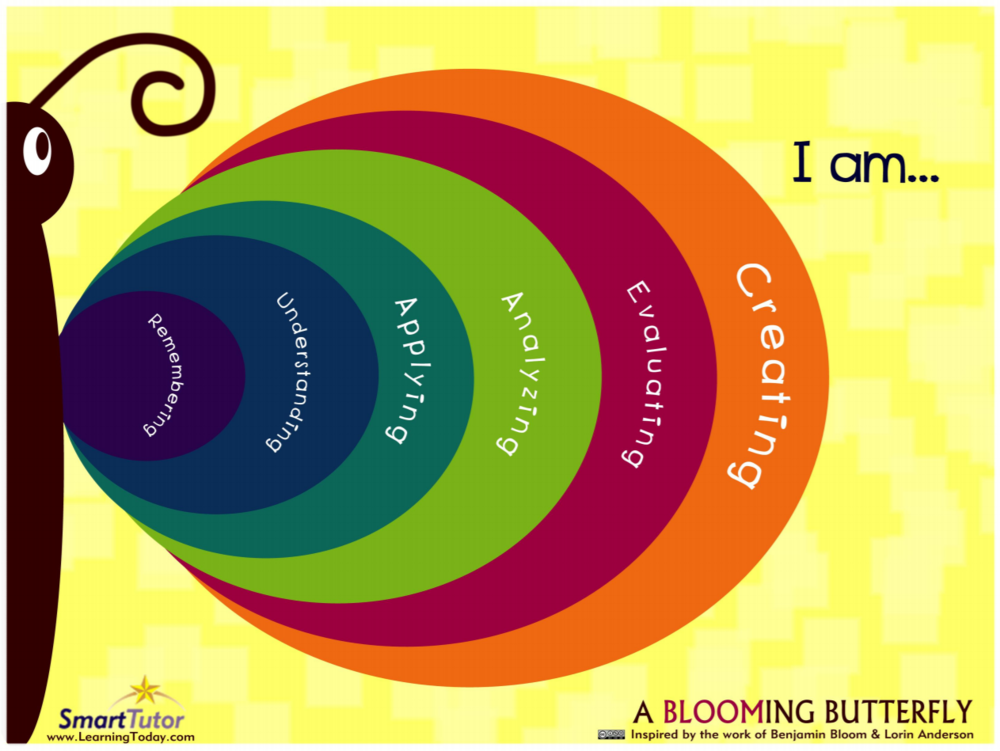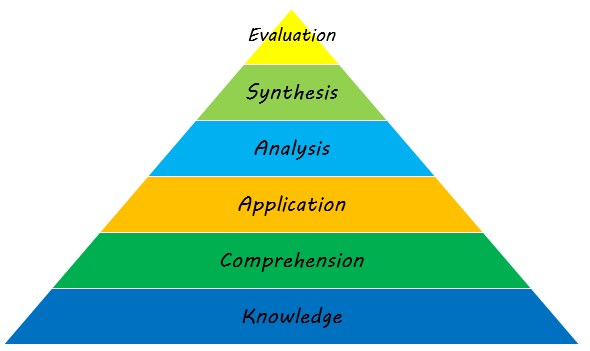- Get link
- X
- Other Apps
- Get link
- X
- Other Apps
Benjamin Bloom (1956) developed three different levels of classifying learning outcomes or objectives. These are cognitive, affective and psycho-motor domains: these classifications are referred to as Bloom’s taxonomy and the stages are divided from the simple to the complex.
Bloom's Taxonomy, (in full: 'Bloom's Taxonomy of Learning Domains', or strictly speaking: Bloom's 'Taxonomy of Educational Objectives') was initially (the first part) published in 1956 under the leadership of American academic and educational expert Dr Benjamin S Bloom. 'Bloom's Taxonomy' was originally created in and for an academic context, (the development commencing in 1948), when Benjamin Bloom chaired a committee of educational psychologists, based in American education, whose aim was to develop a system of categories of learning behaviour to assist in the design and assessment of educational learning.
Bloom's Taxonomy has since been expanded over many years by Bloom and other
contributors (notably Anderson and Krathwhol as recently as 2001, whose
theories extend Bloom's work to far more complex levels than are explained
here, and which are more relevant to the field of academic education than to
corporate training and development).
Where
indicated Bloom's Taxonomy tables are adapted and reproduced with permission
from Allyn & Bacon, Boston USA, being the publishers and copyright owners
of 'Taxonomy of Educational Objectives'.
These
stages assist the teacher in writing the objectives, designing the learning
tasks or activities and also to prepare the assessments. These domains are:
COGNITIVE DOMAIN OF LEARNING OUTCOME
The
cognitive domain of learning objectives deals with knowledge acquisition. It
emphasises the development of mental or intellectual skills. There are six
categories of this and they range from the simplest to the most complex one.
1. Knowledge: Is the simplest learning
outcome. It is expected that at the end of this learning task, a learner should
be able to define, identify, mention, describe, list, state, name and label a
previously learnt fact or information. Example of this is that at the end of
this lesson, a learner should be able to mention categories of Bloom’s taxonomy
of learning.
2. Comprehension: This is the second level in cognitive domain. It is a
level where the learners learn to understand, translate, summarize, interpret,
rewrite, predict or explain the facts, principles, concepts, tasks or
information. At the end of this lesson, a student should be able to summarize
all the three types of domain.
3. Application: At this level, the learners should be able to apply
the previously gained experiences into new task, principles, information, rules
and facts. Application may involve changing, operating manipulating, relating
etc. For instance, at the end of this lesson, a student should be able to apply
the knowledge gained in the study of Bloom’s taxonomy into the classroom
situation.
4. Analysis: This is the fourth stage in cognitive domain. It is
the ability of the learners to distinguish, compare, contrast, relate, select
or differentiate between the facts or making inferences.
5. Synthesis: Building or creating new tasks, facts, principles,
logic, methods from constituent elements or diverse points. It is about putting
parts together to form a whole, with emphasis on creating a new meaning or structure. Synthesis involves Examples are
composition, compilation, explanation, modification, reconstruction, relating,
rearranging, revision etc.
6. Evaluation: This is the ability of the learners to make judgment
or pass comments about an event, information. It takes the form of assessment,
defence, criticism, justification, relating, describing etc.
AFFECTIVE DOMAIN OF LEARNING OUTCOME
The
Affective domain gives judgment about our emotion. It describes
how we deal with our feelings, values, appreciation, attitudes or motivation.
This domain is divided into five categories. These are:
1.
Receiving Information or fact: This deals with how we receive information being
passed onto us. It emphasizes our willingness to hear or listen to others.
2.
Responding to Information: The level of responsiveness of the learners to
learning tasks are judged in this area. It describes the willingness of the
learners to respond to a given task satisfactorily. It is about how well the
learners participate in the teaching-learning activities.
3.
Valuing:
This is the value a person attaches to a behaviour or phenomenon. Value is
based on the internalization of a set of specified values, while the clues to
these values are expressed in the learner’s overt behaviour and are often
identifiable.
4.
Organisation:
This is the process of organizing values into priorities in order to compare
them and decide on the most appropriate ones.
5.
Internalising Values: This means that individuals have values that are consistent, stable
and are controlling them. These values which form the characteristics of people
can therefore predict their behaviour.
PSYCHO-MOTOR DOMAIN
The Psychomotor Domain encompasses skills development relating to the
physical dimensions of accomplishing a task. Because, 'motor' skills extend
beyond the originally traditionally imagined manual and physical skills, always
consider using this domain, even if you think your environment is covered
adequately by the Cognitive and Affective Domains. Whatever the situation, it
is likely that the Psychomotor Domain is significant.
This
level of domain is about physical skills. It deals with physical movement and
coordination of an individual. These skills involve manipulation of fingers,
legs and other parts of the body. Examples are cycling, dancing, running etc.
Psycho-motor is divided into perception, set, guided response, mechanism,
complex over response, adaptation and origination.
The table below summarises Elizabeth
Simpson's interpretation of the Psychomotor domain which is the more
comprehensive version and is probably preferable model for the development of
young children.
|
PSYCHOMOTOR DOMAIN (SIMPSON) |
||||
|
level |
category or 'level' |
description |
examples of activity or demonstration and evidence
to be measured |
'key words' (verbs which describe the activity to be
trained or measured at each level) |
|
1 |
Perception |
awareness |
use and/or selection of senses to absorb data for
guiding movement |
recognise, distinguish, notice, touch , hear, feel,
etc |
|
2 |
Set |
readiness |
mental, physical or emotional preparation before
experience or task |
arrange, prepare, get set |
|
3 |
Guided Response |
attempt |
imitate or follow instruction, trial and error |
imitate, copy, follow, try |
|
4 |
Mechanism |
basic proficiency |
competently respond to stimulus for action |
make, perform, shape, complete |
|
5 |
Complex Overt Response |
expert proficiency |
execute a complex process with expertise |
coordinate, fix, demonstrate |
|
6 |
Adaptation |
adaptable proficiency |
alter response to reliably meet varying
challenges |
adjust, integrate, solve |
|
7 |
Origination |
creative proficiency |
develop and execute new integrated responses and
activities |
design, formulate, modify, re-design,
trouble-shoot |
Table 1: Simpson's Psychomotor Domain is represented in an altered and condensed manner in "The Classification of Educational Objectives in the Psychomotor Domain," published in 1972. Actually, it appears that Elizabeth Simpson initially discussed her understanding of the Psychomotor Domain in 1966 in the Illinois Journal of Home Economics. As a result, the theory may be dated to either 1966 or 1972.


Comments
Post a Comment